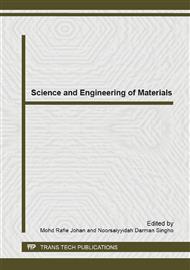p.136
p.143
p.147
p.155
p.166
p.172
p.177
p.187
p.192
Modeling the Release of Urea from Coated Urea: The Constant Release Stage
Abstract:
Controlled release fertilizer (CRF) plays an important role in nutrient loss prevention by plants and its utilization enhancement. This study uses multi-diffusion model to simulate the release of urea for two coating materials: modified polyolefin (MPO) and latex film, based on COMSOL Multiphysics software. Effective diffusivity and lag time (t0) are determined based on experimental data. Modeling results well simulate the experimental data of "constant release" stage. Standard error of estimate (SEE) ranges from 0.012 - 0.017 for MPO and 0.0316 for Latex film. The validated model is then utilized to study the effect of coating thickness (l), saturated urea concentration (Csat) and effective diffusivity (De) on the urea release profile. Release time increase with increasing coating thickness or decreasing saturated urea concentration, effective diffusivity. In addition, a change in effective diffusivity does not make significant change in percentage of urea at the end of "constant release" stage.
Info:
Periodical:
Pages:
166-171
Citation:
Online since:
June 2014
Authors:
Price:
Сopyright:
© 2014 Trans Tech Publications Ltd. All Rights Reserved
Share:
Citation:


